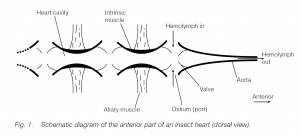Functions of Blood
Except in very small animals (e.g. flatworms) or those with very low metabolic rates (e.g. jellyfishes), simple diffusion from the surface of the body cannot distribute gases and nutrients, metabolites and excretory products, and hormones and defense components to the relevant cells. Most animals contain a transport fluid (blood or hemolymph): localized stirring of the fluid by bodily movement is enough to facilitate transport in simple animals; some form of mechanical pumping must be used in larger, more complex forms.
Blood has the following functions:
- transport of nutrients, metabolites, waste products, hormones and other messenger substances, defense components, heat;
- transport of cells (e.g. thrombocytes, lymphocytes);
- force transmission (e.g. hydrostatic skeleton in oligochaetes, crustacean molt, mammalian penis erection).
The circulatory principle is first encountered in the cytoplasmic streaming of protoctistans.
Components of the circulatory system
In Metazoa, the circulatory system has three components:
- vessels (arteries, capillaries, veins and lymphatics);
- pump (heart);
- fluid (blood, lymph or hemolymph).
Open and closed Circulations
Open circulations (e.g. crustaceans, insects, lampreys)
- Low pressure
- No sustained pressure
- Little regulation of blood or hemolymph flow to organs
- Slow return of blood or hemolymph to pump
Closed circulations (e.g. earthworms, cephalopods, most vertebrates)
- High pressure with elastic vessel walls sustaining the pressure
- Regulation of distribution of blood flow to the organs
- Rapid return of blood or hemolymph to the heart
Invertebrate circulations and hearts
In many invertebrate phyla, the coelomic fluid acts as a circulatory system. A circulation is lacking in sponges, cnidarians and flatworms, and is only slightly developed in ribbonworms and most ‘protochordates’ (e.g. acorn-worms and tunicates).
Invertebrate hearts are very varied in form, but are usually dorsally situated. The mollusc heart is dorsal with one or two receptor atria and a single, muscular ventricle pumping blood to arteries leading to organs. In earthworms, there are dorsal and ventral longitudinal blood vessels, connected by paired circular vessels in most segments. Pumping is by peristaltic contraction of the middorsal vessel and five pairs of anterior, lateral ‘hearts’ connecting the dorsal and ventral vessels.
Arthropod hearts are dorsal and contraction is neurogenic. (The rhythmicity of contraction is under the control of motor nerves innervating the heart, unlike the situation in the myogenic mammalian heart where the organ has its own intrinsic rhythmicity originating in the pacemaker.) Crustacean hearts are compact and roughly spherical; insect hearts are slender, elongated tubes which work on a suction pump principle.
Aliary muscles contract to expand the heart volume, and hemolymph (blood) is sucked in through segmental, lateral ostia. Intrinsic muscles in the heart wall contract to propel bloodforwards through a dorsal aorta to the hemocoel cavity in which the organs are bathed in hemolymph: valves prevent the outflow of hemolymph through the lateral ostia. Pressure is lost as the hemolymph is passed out into the hemocoel. Insect hemolymph carries food and waste products, etc., but respiratory gases are exchanged through the tracheal system.

